Effect of Pulp Pigmentation Intensity on Consumer Acceptance of New Blood Mandarins: A Cross-Cultural Study in Spain and Italy
Abstract
:1. Introduction
2. Materials and Methods
2.1. Consumer Sample
2.2. Samples
2.3. Questionnaire Design
2.3.1. Presentation of the Study
2.3.2. Consumer Choice
2.3.3. Naturalness and Healthiness Perception
2.3.4. Acceptance and Purchase Intention
2.4. Data Analysis
3. Results
3.1. Consumer Choice
3.2. Purchase Intention (PI)
3.3. Consumer Perception and Expected Liking
4. Discussion
4.1. Uninformed Consumers’ Preferences and Familiarity Effect
4.2. Effect of Information on Consumer Preferences
5. Conclusions
Author Contributions
Funding
Institutional Review Board Statement
Informed Consent Statement
Data Availability Statement
Acknowledgments
Conflicts of Interest
References
- FAO. FAOSTAT 2022. Available online: https://www.fao.org/faostat/es/#data/QCL (accessed on 4 April 2022).
- Goldenberg, L.; Yaniv, Y.; Porat, R.; Carmi, N. Mandarin fruit quality: A review. J. Sci. Food Agric. 2018, 98, 18–26. [Google Scholar] [CrossRef]
- Aleza, P.; Juárez, J.; Cuenca, J.; Ollitraul, P.; Navarro, L. Recovery of citrus triploid hybrids by embryo rescue and flow cytometry from 2x× 2x sexual hybridisation and its application to extensive breeding programs. Plant Cell Rep. 2010, 29, 1023–1034. [Google Scholar] [CrossRef] [PubMed]
- Yu, X.; Zhang, X.; Jiang, D.; Zhu, S.; Cao, L.; Liu, X.; Shen, W.; Zhao, W.; Zhao, X. Genetic diversity of the ease of peeling in mandarins. Sci. Hortic. 2021, 278, 109852. [Google Scholar] [CrossRef]
- Tarancón, P.; Tárrega, A.; Aleza, P.; Besada, C. Consumer description by check-all-that-apply questions (CATA) of the sensory profiles of commercial and new mandarins. identification of preference patterns and drivers of liking. Foods 2020, 9, 468. [Google Scholar] [CrossRef] [PubMed] [Green Version]
- Tarancón, P.; Giménez-Sanchis, A.; Aleza, P.; Besada, C. Selection of New Late-Season Mandarin Cultivars Based on Sensory Changes and Consumer Acceptance after Fruit Cold Storage. Agronomy 2021, 11, 116. [Google Scholar] [CrossRef]
- Giménez-Sanchis, A.; Tárrega, A.; Tarancón, P.; Aleza, P.; Besada, C. Check-All-That-Apply Questions including the Ideal Product as a Tool for Selecting Varieties in Breeding Programs. A Case Study with Mandarins. Agronomy 2021, 11, 2243. [Google Scholar] [CrossRef]
- Caruso, M.; Continella, A.; Modica, G.; Pannitteri, C.; Russo, R.; Salonia, F.; Arlotta, C.; Gentile, A.; Russo, G. Rootstocks influence yield precocity, productivity, and pre-harvest fruit drop of mandared pigmented mandarin. Agronomy 2020, 10, 1305. [Google Scholar] [CrossRef]
- Rapisarda, P.; Fabroni, S.; Peterek, S.; Russo, G.; Mock, H.P. Juice of new citrus hybrids (Citrus clementina Hort. ex Tan.× C. sinensis L. Osbeck) as a source of natural antioxidants. Food Chem. 2009, 117, 212–218. [Google Scholar] [CrossRef]
- Rapisarda, P.; Bellomo, S.E.; Fabroni, S.; Russo, G. Juice quality of two new mandarin-like hybrids (Citrus clementina Hort. ex Tan x Citrus sinensis L. Osbeck) containing anthocyanins. J. Agric. Food Chem. 2008, 56, 2074–2078. [Google Scholar] [CrossRef]
- Buscemi, S.; Rosafio, G.; Arcoleo, G.; Mattina, A.; Canino, B.; Montana, M.; Verga, S.; Rini, G. Effects of red orange juice intake on endothelial function and inflammatory markers in adult subjects with increased cardiovascular risk. Am. J. Clin. Nutr. 2012, 95, 1089–1095. [Google Scholar] [CrossRef] [Green Version]
- Grosso, G.; Galvano, F.; Mistretta, A.; Marventano, S.; Nolfo, F.; Calabrese, G.; Buscemi, S.; Drago, F.; Veronesi, U.; Scuderi, A. Red orange: Experimental models and epidemiological evidence of its benefits on human health. Oxid. Med. Cell. Longev. 2013, 2013, 157240. [Google Scholar] [CrossRef] [PubMed] [Green Version]
- Recupero, G.R.; Russo, G.; Recupero, S. New promising citrus triploid hybrids selected from crosses between monoembryonic diploid female and tetraploid male parents. HortScience 2005, 40, 516–520. [Google Scholar] [CrossRef]
- Giménez-Sanchis, A.; Zhong, K.; Pintor, A.; Farina, V.; Besada, C. Understanding Blood versus Blond Orange Consumption: A Cross-Cultural Study in Four Countries. Foods 2022, 11, 2686. [Google Scholar] [CrossRef] [PubMed]
- Navarro, L. The Spanish citrus industry. Acta Hortic. 2015, 1065, 41–48. [Google Scholar] [CrossRef]
- Cebadera-Miranda, L.; Domínguez, L.; Días, M.I.; Barros, L.; Ferreira, I.C.; Igual, M.; Martínez-Navarrete, N.; Fernández-Ruiz, V.; Morales, P.; Cámara, M. Sanguinello and Tarocco (Citrus sinensis [L.] Osbeck): Bioactive compounds and colour appearance of blood oranges. Food Chem. 2019, 270, 395–402. [Google Scholar] [CrossRef] [PubMed] [Green Version]
- Tarancón, P.; Cebrián, B.; Fernández-Serrano, P.; Besada, C. Relation between Rind Pigmentation and Internal Quality of Blood Orange ‘Sanguinelli’: Physicochemical and Sensory Studies. Horticulturae 2022, 8, 448. [Google Scholar] [CrossRef]
- Paakki, M.; Sandell, M.; Hopia, A. Consumer’s reactions to natural, atypically colored foods: An investigation using blue potatoes. J. Sens. Stud. 2016, 31, 78–89. [Google Scholar] [CrossRef]
- Schifferstein, H.; Wehrle, T.; Carbon, C.C. Consumer expectations for vegetables with typical and atypical colors: The case of carrots. Food Qual. Prefer. 2019, 72, 98–108. [Google Scholar] [CrossRef]
- Jaeger, S.R.; Harker, F.R. Consumer evaluation of novel kiwifruit: Willingness-to-pay. J. Sci. Food Agric. 2005, 85, 2519–2526. [Google Scholar] [CrossRef]
- Zanetti, M.; Samoggia, A.; Young, J. Fruit sector strategic management: An exploration of agro-food chain actors’ perception of market sustainability of apple innovation. Sustainability 2020, 12, 6542. [Google Scholar] [CrossRef]
- Sabbe, S.; Verbeke, W.; Deliza, R.; Matta, V.; Van Damme, P. Effect of a health claim and personal characteristics on consumer acceptance of fruit juices with different concentrations of açaí (Euterpe oleracea Mart.). Appetite 2009, 53, 84–92. [Google Scholar] [CrossRef] [PubMed]
- Ares, G.; Gimenez, A.; Gambaro, A. Consumer perceived healthiness and willingness to try functional milk desserts. Influence of ingredient, ingredient name and health claim. Food Qual. Prefer. 2009, 20, 50–56. [Google Scholar] [CrossRef]
- Vidigal, M.C.; Minim, V.P.; Carvalho, N.B.; Milagres, M.P.; Gonçalves, A.C. Effect of a health claim on consumer acceptance of exotic Brazilian fruit juices: Açaí (Euterpe oleracea Mart.), Camu-camu (Myrciaria dubia), Cajá (Spondias lutea L.) and Umbu (Spondias tuberosa Arruda). Food Res. Int. 2011, 44, 1988–1996. [Google Scholar] [CrossRef]
- Galmarini, M.V.; Symoneaux, R.; Chollet, S.; Zamora, M.C. Understanding apple consumers’ expectations in terms of likes and dislikes. Use of comment analysis in a cross-cultural study. Appetite 2013, 62, 27–36. [Google Scholar] [CrossRef] [Green Version]
- Tarancón, P.; Pintor-Jardines, A.; Escalona-Buendía, H.B.; Besada, C. Effect of information about mandarin internal maturity on consumer hedonic and sensory expectations: A cross-cultural study in Spain and Mexico. J. Sci. Food Agric. 2021, 101, 6586–6594. [Google Scholar] [CrossRef]
- Jamir, S.M.R.; Stelick, A.; Dando, R. Cross-cultural examination of a product of differing familiarity (Hard Cider) by American and Chinese panelists using rapid profiling techniques. Food Qual. Prefer. 2020, 79, 103783. [Google Scholar] [CrossRef]
- Joshi, A.; Kale, S.; Chandel, S.; Pal, D.K. Likert scale: Explored and explained. Br. J. Appl. Sci. 2015, 7, 396–403. [Google Scholar] [CrossRef]
- Lawless, H.T.; Popper, R.; Kroll, B.J. A comparison of the labeled magnitude (LAM) scale, an 11-point category scale and the traditional 9-point hedonic scale. Food Qual. Prefer. 2010, 21, 4–12. [Google Scholar] [CrossRef]
- Wright, M.; MacRae, M. Bias and variability in purchase intention scales. J. Acad. Mark. Sci. 2007, 35, 617–624. [Google Scholar] [CrossRef]
- Morales, J.; Bermejo, A.; Navarro, P.; Forner-Giner, M.Á.; Salvador, A. Rootstock effect on fruit quality, anthocyanins, sugars, hydroxycinnamic acids and flavanones content during the harvest of blood oranges ‘Moro’ and ‘Tarocco Rosso’grown in Spain. Food Chem. 2021, 342, 128305. [Google Scholar] [CrossRef]
- Lee, S.M.; Lee, K.T.; Lee, S.H.; Song, J.K. Origin of human colour preference for food. J. Food Eng. 2013, 119, 508–515. [Google Scholar] [CrossRef]
- Lazard, A.J.; Mackert, M.S.; Bock, M.A.; Love, B.; Dudo, A.; Atkinson, L. Visual assertions: Effects of photo manipulation and dual processing for food advertisements. Vis. Commun. Q. 2018, 25, 16–30. [Google Scholar] [CrossRef]
- Siddiqui, S.A.; Zannou, O.; Karim, I.; Awad, N.M.; Gołaszewski, J.; Heinz, V.; Smetana, S. Avoiding Food Neophobia and Increasing Consumer Acceptance of New Food Trends—A Decade of Research. Sustainability 2022, 14, 10391. [Google Scholar] [CrossRef]
- Román, S.; Sánchez-Siles, L.M.; Siegrist, M. The importance of food naturalness for consumers: Results of a systematic review. Trends Food Sci. Technol. 2017, 67, 44–57. [Google Scholar] [CrossRef]
- Sulistyawati, I.; Sijtsema, S.; Dekker, M.; Verkerk, R.; Steenbekkers, B. Exploring consumers’ health perception across cultures in the early stages of new product development: Dried mango as a case study. Br. Food J. 2019, 121, 2116–2131. [Google Scholar] [CrossRef]
- Ávila, B.P.; Cardozo, L.O.; Alves, G.D.; Pereira, A.M.; Gularte, M.A.; de Oliveira, R.P. Targeted Chemical and Sensory Profiling to Guide Consumption of Blood Orange. J. Culin. Sci. Technol. 2020, 20, 350–365. [Google Scholar] [CrossRef]
- Schirmacher, H.; Elshiewy, O.; Boztug, Y. That’s not natural! Consumer response to disconfirmed expectations about ‘natural’ food. Appetite 2022, 179, 106270. [Google Scholar] [CrossRef]
- Simons, T.J.; McNeil, C.J.; Pham, V.D.; Suh, J.H.; Wang, Y.; Slupsky, C.M.; Guinard, J.X. Evaluation of California-grown blood and Cara Cara oranges through consumer testing, descriptive analysis, and targeted chemical profiling. J. Food Sci. 2019, 84, 3246–3263. [Google Scholar] [CrossRef]
- Fernan, C.; Schuldt, J.P.; Niederdeppe, J. Health halo effects from product titles and nutrient content claims in the context of “protein” bars. Health Commun. 2018, 33, 1425–1433. [Google Scholar] [CrossRef]
- Stoltze, F.M.; Busey, E.; Taillie, L.S.; Carpentier, F.R.D. Impact of warning labels on reducing health halo effects of nutrient content claims on breakfast cereal packages: A mixed-measures experiment. Appetite 2021, 163, 105229. [Google Scholar] [CrossRef]
- Wansink, B.; Chandon, P. Can “low-fat” nutrition labels lead to obesity? J. Mark. Res. 2006, 43, 605–617. [Google Scholar] [CrossRef]
- McSweeney, M.B. The effect of health-related claims on consumers’ sensory perception. Curr. Opin. Food Sci. 2022, 47, 100893. [Google Scholar] [CrossRef]
- Barauskaite, D.; Gineikiene, J.; Fennis, B.M.; Auruskeviciene, V.; Yamaguchi, M.; Kondo, N. Eating healthy to impress: How conspicuous consumption, perceived self-control motivation, and descriptive normative influence determine functional food choices. Appetite 2018, 131, 59–67. [Google Scholar] [CrossRef] [PubMed]
- Kallas, Z.; Vitale, M.; Gil, J.M. Health innovation in patty products. the role of food neophobia in consumers’ non-hypothetical willingness to pay, purchase intention and hedonic evaluation. Nutrients 2019, 11, 444. [Google Scholar] [CrossRef] [Green Version]
- Biondi, B.; Camanzi, L. Nutrition, hedonic or environmental? The effect of front-of-pack messages on consumers’ perception and purchase intention of a novel food product with multiple attributes. Food Res. Int. 2020, 130, 108962. [Google Scholar] [CrossRef]
- Goulart, G.d.S.; Viana, M.M.; Lucchese-Cheung, T. Consumer perception towards familiar and innovative foods: The case of a Brazilian product. Br. Food J. 2021, 123, 125–142. [Google Scholar] [CrossRef]
- Tuorila, H.; Hartmann, C. Consumer responses to novel and unfamiliar foods. Curr. Opin. Food Sci. 2020, 33, 1–8. [Google Scholar] [CrossRef]
- Hartmann, C.; Ruby, M.B.; Schmidt, P.; Siegrist, M. Brave, health-conscious, and environmentally friendly: Positive impressions of insect food product consumers. Food Qual. Prefer. 2018, 68, 64–71. [Google Scholar] [CrossRef]
- Arancia Rossa di Sicilia IGP. 2022. Available online: https://www.tutelaaranciarossa.it/ (accessed on 9 September 2022).
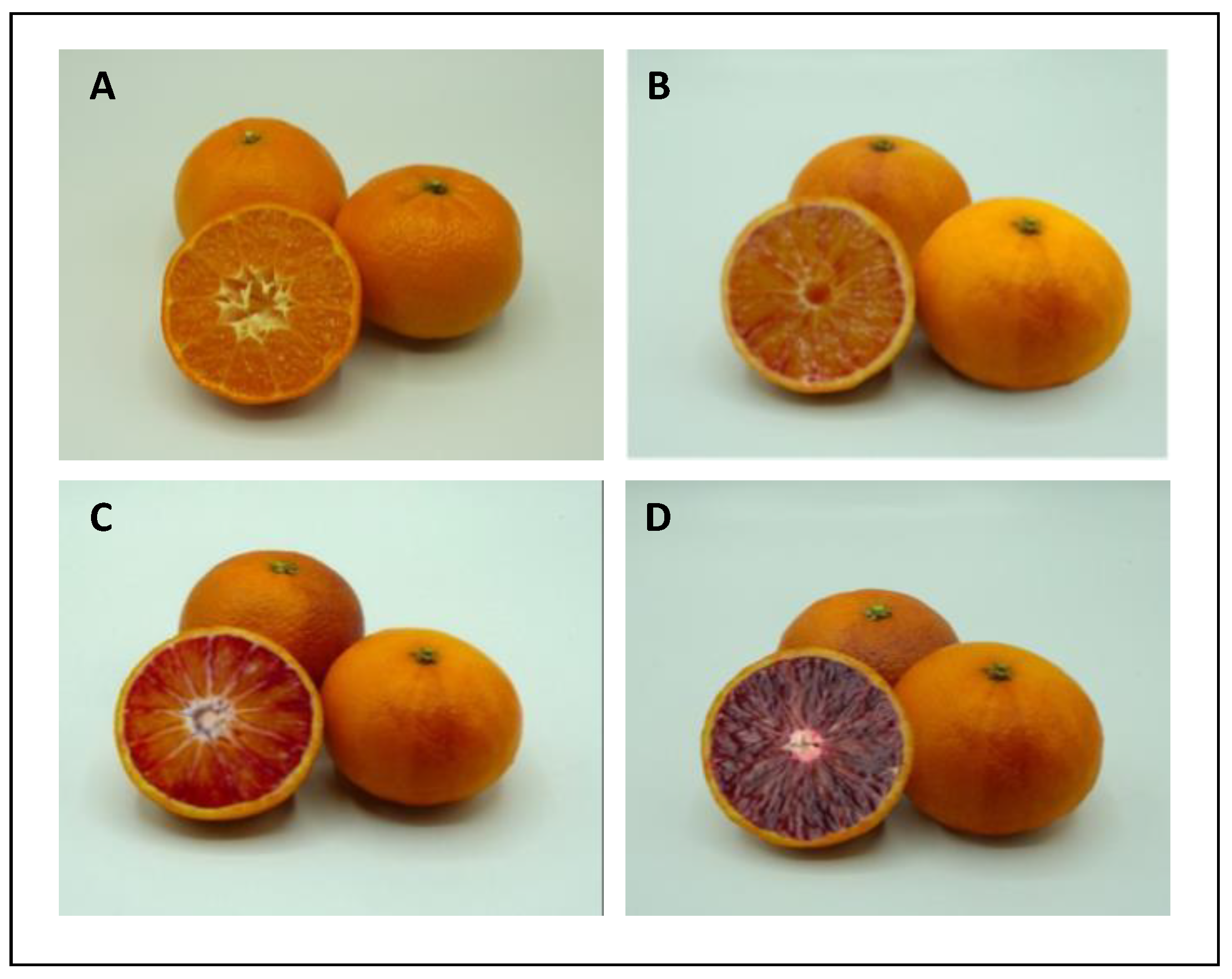
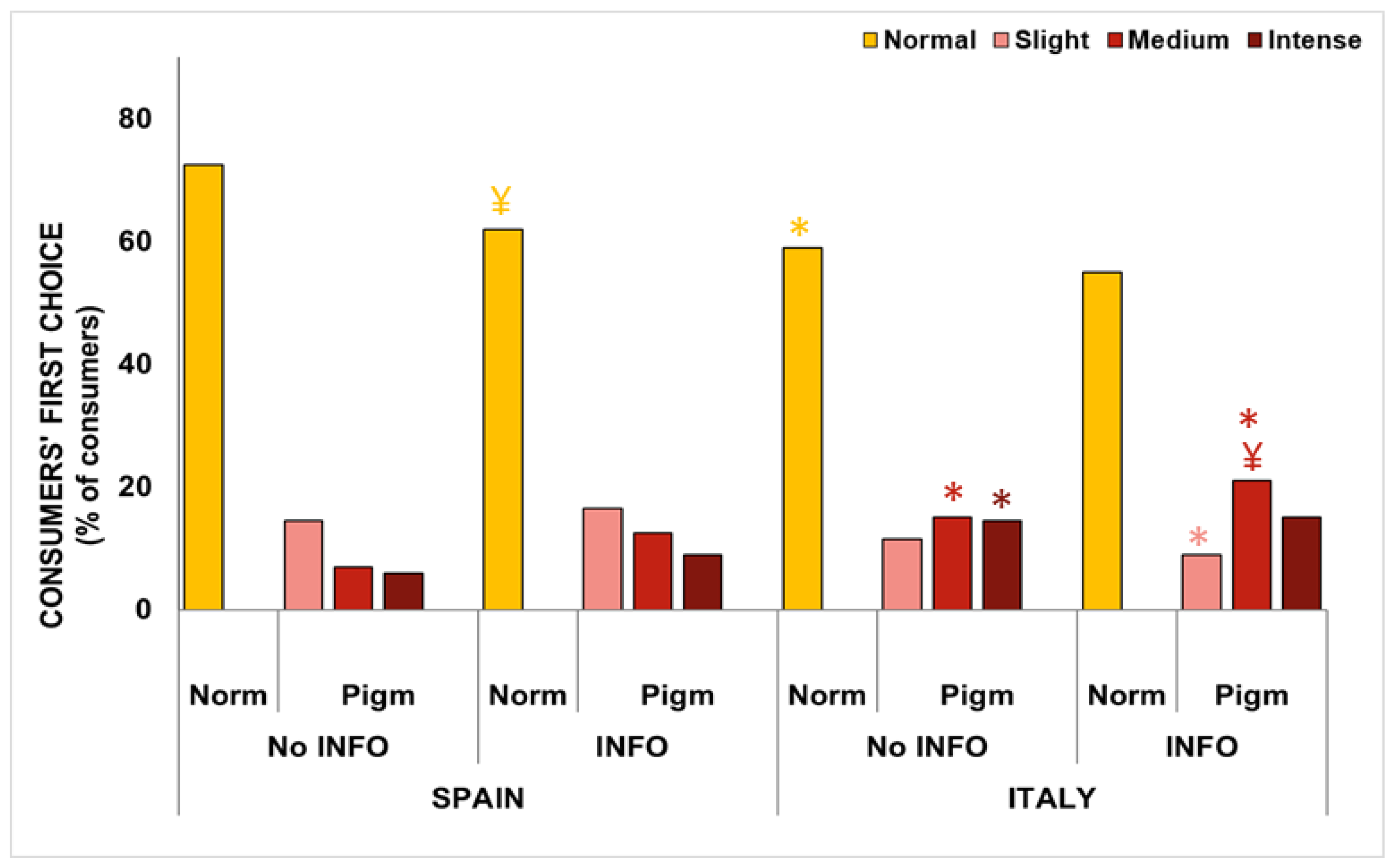
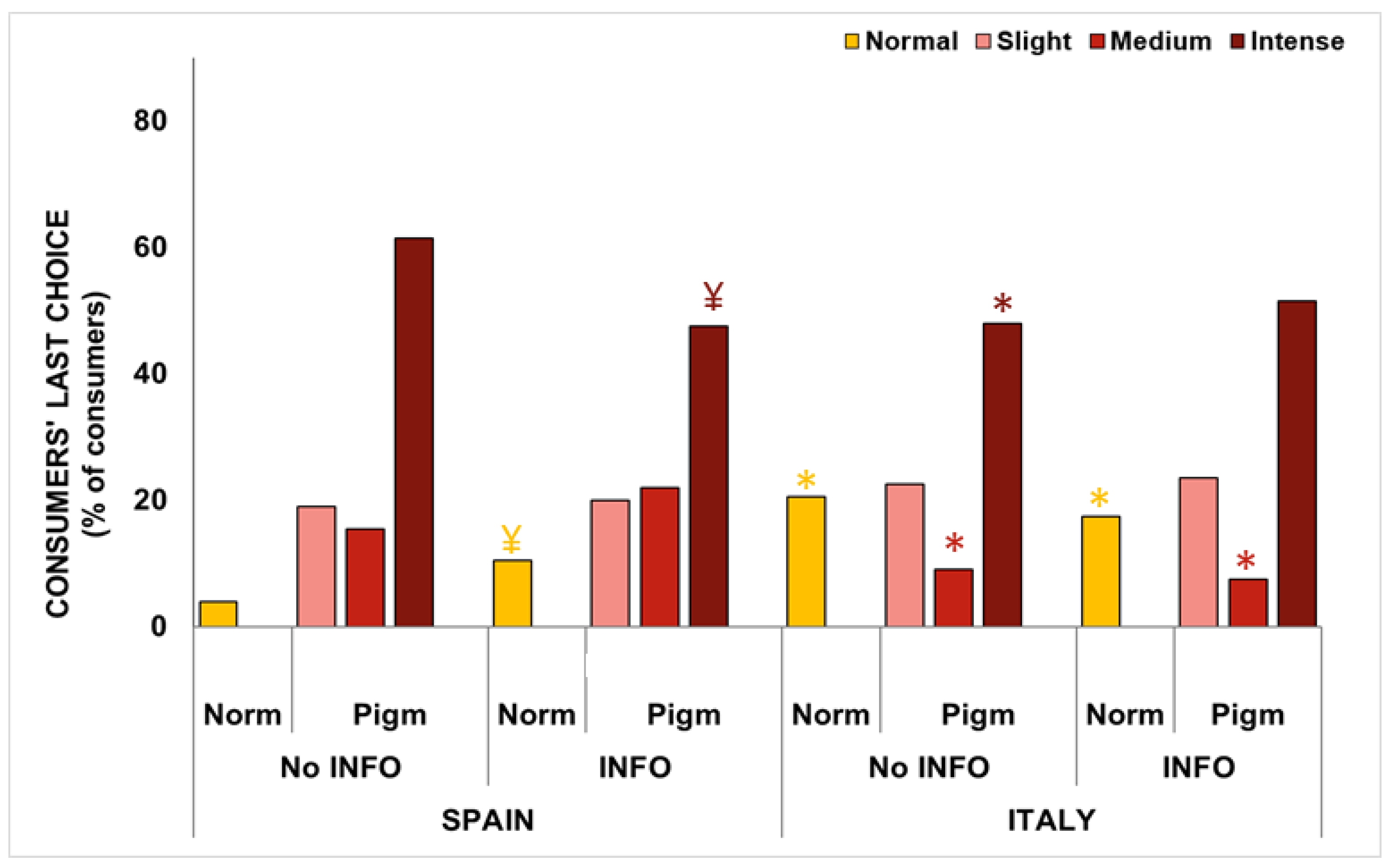
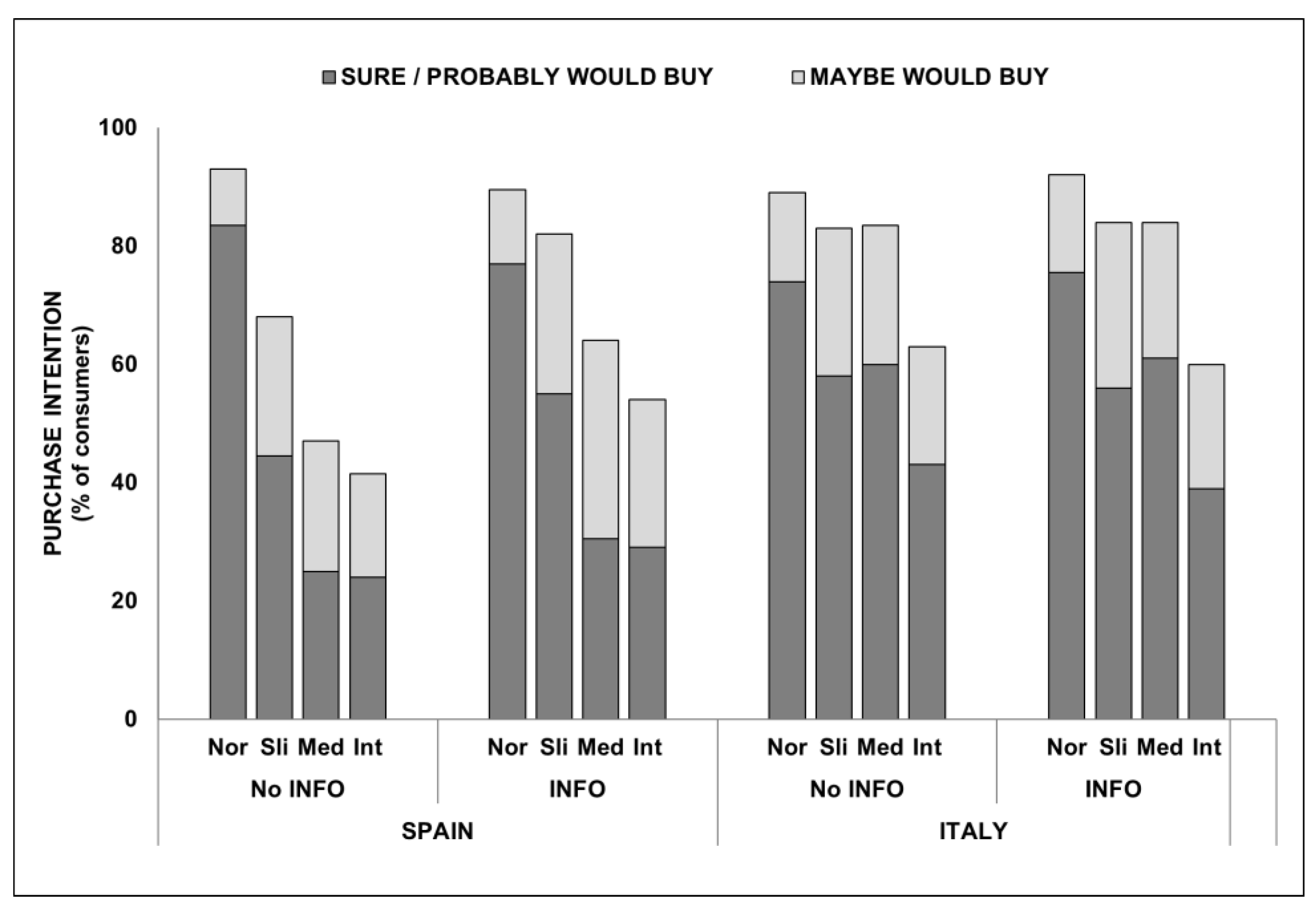
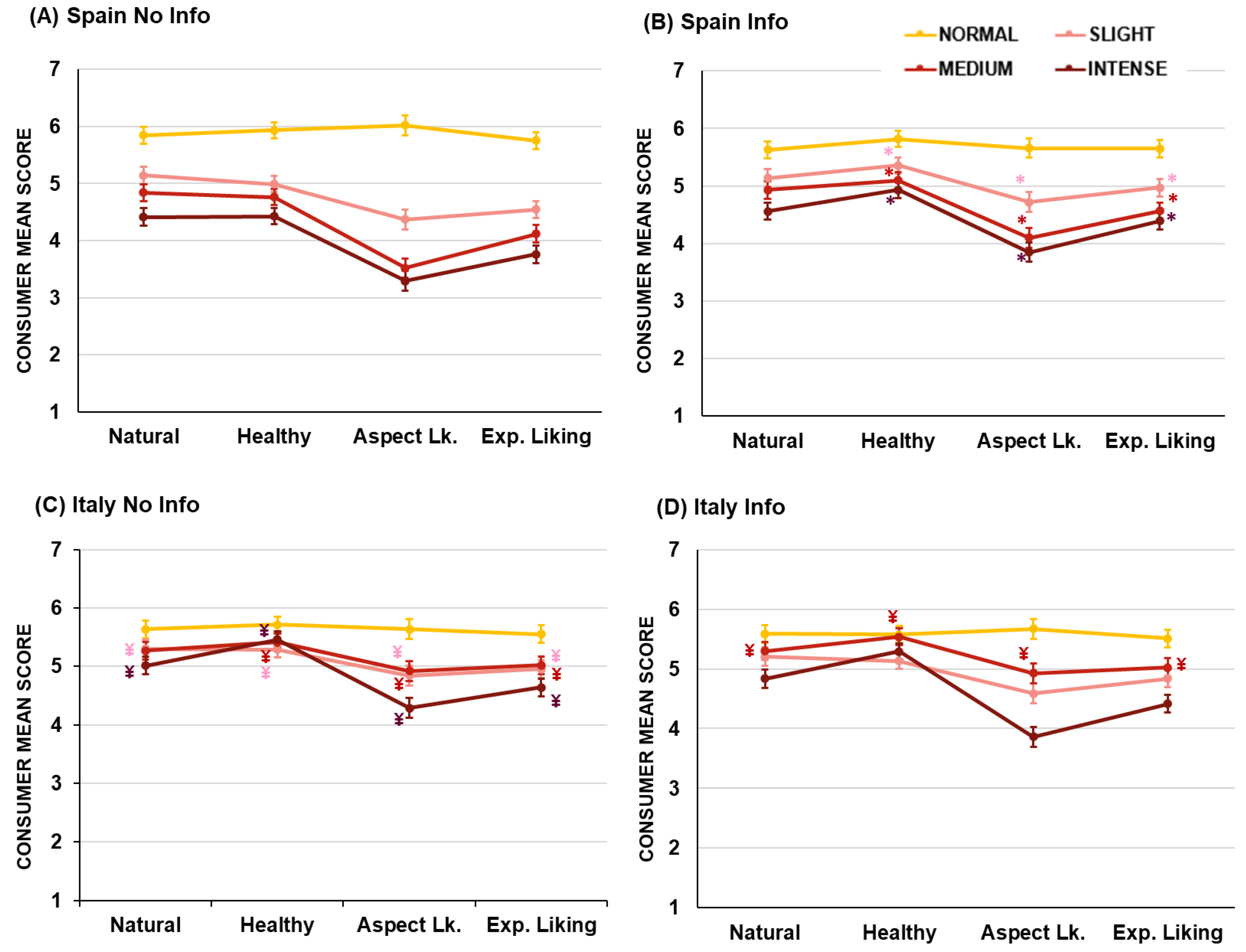
| NORMAL | SLIGHT | MEDIUM | INTENSE | |||||||
|---|---|---|---|---|---|---|---|---|---|---|
| Fam. | Unf. | Fam. | Unf. | Fam. | Unf. | Fam. | Unf. | |||
| SPAIN | NO INFO | Natural | 6.1 | 5.8 | 5.7 | 5.0 * | 5.8 | 4.6 * | 5.2 | 4.2 * |
| Healthy | 6.1 | 5.9 | 5.3 | 4.9 | 5.6 | 4.6 * | 5.1 | 4.3 * | ||
| Aspect L. | 6.1 | 6.0 | 5.1 | 4.2 * | 4.9 | 3.2 * | 4.8 | 3.0 * | ||
| Ex. Liking | 6.0 | 5.7 | 5.1 | 4.4 * | 5.4 | 3.8 * | 4.9 | 3.5 * | ||
| INFO | Natural | 5.7 | 5.6 | 5.4 | 5.1 | 5.6 | 4.8 * | 5.3 | 4.5 * | |
| Healthy | 5.9 | 5.8 | 5.1 | 5.4 | 5.5 | 5.0 | 5.3 | 4.9 | ||
| Aspect L. | 5.8 | 5.6 | 4.5 | 4.8 | 4.4 | 4.0 | 4.7 | 3.7 * | ||
| Ex. Liking | 5.9 | 5.6 | 4.8 | 5.0 | 5.3 | 4.5 * | 5.5 | 4.2 * | ||
| ITALY | NO INFO | Natural | 5.7 | 5.5 | 5.4 | 5.0 * | 5.4 | 4.9 * | 5.2 | 4.6 * |
| Healthy | 5.7 | 5.8 | 5.4 | 5.0 * | 5.6 | 5.0 * | 5.7 | 4.9 * | ||
| Aspect L. | 5.5 | 6.0 * | 5.0 | 4.5 * | 5.2 | 4.3 * | 4.6 | 3.4 * | ||
| Ex. Liking | 5.5 | 5.7 | 5.1 | 4.5 * | 5.3 | 4.2 * | 5.1 | 3.5 * | ||
| INFO | Natural | 5.6 | 5.6 | 5.2 | 5.3 | 5.3 | 5.2 | 4.9 | 4.7 | |
| Healthy | 5.6 | 5.6 | 5.1 | 5.1 | 5.6 | 5.3 | 5.4 | 4.9 * | ||
| Aspect L. | 5.5 | 6.1 * | 4.7 | 4.3 | 5.2 | 4.2 * | 4.3 | 2.7 * | ||
| Ex. Liking | 5.4 | 5.7 | 5.0 | 4.5 * | 5.4 | 4.1 * | 4.8 | 3.4 * | ||
Publisher’s Note: MDPI stays neutral with regard to jurisdictional claims in published maps and institutional affiliations. |
© 2022 by the authors. Licensee MDPI, Basel, Switzerland. This article is an open access article distributed under the terms and conditions of the Creative Commons Attribution (CC BY) license (https://creativecommons.org/licenses/by/4.0/).
Share and Cite
Giménez-Sanchis, A.; Pons-Gómez, A.; Farina, V.; Besada, C. Effect of Pulp Pigmentation Intensity on Consumer Acceptance of New Blood Mandarins: A Cross-Cultural Study in Spain and Italy. Agronomy 2022, 12, 3058. https://doi.org/10.3390/agronomy12123058
Giménez-Sanchis A, Pons-Gómez A, Farina V, Besada C. Effect of Pulp Pigmentation Intensity on Consumer Acceptance of New Blood Mandarins: A Cross-Cultural Study in Spain and Italy. Agronomy. 2022; 12(12):3058. https://doi.org/10.3390/agronomy12123058
Chicago/Turabian StyleGiménez-Sanchis, Adrián, Ana Pons-Gómez, Vittorio Farina, and Cristina Besada. 2022. "Effect of Pulp Pigmentation Intensity on Consumer Acceptance of New Blood Mandarins: A Cross-Cultural Study in Spain and Italy" Agronomy 12, no. 12: 3058. https://doi.org/10.3390/agronomy12123058
APA StyleGiménez-Sanchis, A., Pons-Gómez, A., Farina, V., & Besada, C. (2022). Effect of Pulp Pigmentation Intensity on Consumer Acceptance of New Blood Mandarins: A Cross-Cultural Study in Spain and Italy. Agronomy, 12(12), 3058. https://doi.org/10.3390/agronomy12123058








